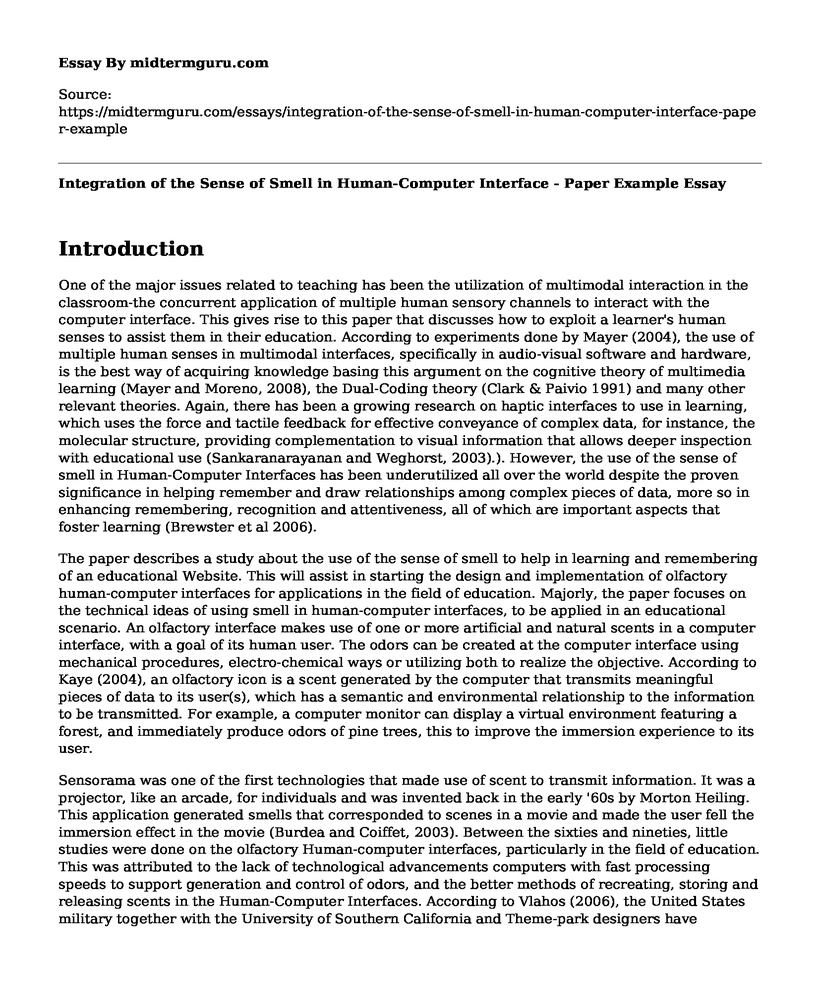Introduction
One of the major issues related to teaching has been the utilization of multimodal interaction in the classroom-the concurrent application of multiple human sensory channels to interact with the computer interface. This gives rise to this paper that discusses how to exploit a learner's human senses to assist them in their education. According to experiments done by Mayer (2004), the use of multiple human senses in multimodal interfaces, specifically in audio-visual software and hardware, is the best way of acquiring knowledge basing this argument on the cognitive theory of multimedia learning (Mayer and Moreno, 2008), the Dual-Coding theory (Clark & Paivio 1991) and many other relevant theories. Again, there has been a growing research on haptic interfaces to use in learning, which uses the force and tactile feedback for effective conveyance of complex data, for instance, the molecular structure, providing complementation to visual information that allows deeper inspection with educational use (Sankaranarayanan and Weghorst, 2003).). However, the use of the sense of smell in Human-Computer Interfaces has been underutilized all over the world despite the proven significance in helping remember and draw relationships among complex pieces of data, more so in enhancing remembering, recognition and attentiveness, all of which are important aspects that foster learning (Brewster et al 2006).
The paper describes a study about the use of the sense of smell to help in learning and remembering of an educational Website. This will assist in starting the design and implementation of olfactory human-computer interfaces for applications in the field of education. Majorly, the paper focuses on the technical ideas of using smell in human-computer interfaces, to be applied in an educational scenario. An olfactory interface makes use of one or more artificial and natural scents in a computer interface, with a goal of its human user. The odors can be created at the computer interface using mechanical procedures, electro-chemical ways or utilizing both to realize the objective. According to Kaye (2004), an olfactory icon is a scent generated by the computer that transmits meaningful pieces of data to its user(s), which has a semantic and environmental relationship to the information to be transmitted. For example, a computer monitor can display a virtual environment featuring a forest, and immediately produce odors of pine trees, this to improve the immersion experience to its user.
Sensorama was one of the first technologies that made use of scent to transmit information. It was a projector, like an arcade, for individuals and was invented back in the early '60s by Morton Heiling. This application generated smells that corresponded to scenes in a movie and made the user fell the immersion effect in the movie (Burdea and Coiffet, 2003). Between the sixties and nineties, little studies were done on the olfactory Human-computer interfaces, particularly in the field of education. This was attributed to the lack of technological advancements computers with fast processing speeds to support generation and control of odors, and the better methods of recreating, storing and releasing scents in the Human-Computer Interfaces. According to Vlahos (2006), the United States military together with the University of Southern California and Theme-park designers have developed virtual reality simulators to be used in training U.S soldiers. The researchers have integrated smells to enhance the cool atmosphere of a simulated war zone. The soldiers wear an electronic collar where scents generate from, and each order activated through a wireless connection, according to the events in the virtual environment. For instance, when soldiers shoot in this virtual space, the smell the gunpowder generated by electronic collar they wear. According to Washburn et al (2003), using the human sense of smell in the virtual scene is an effective methodology that supports education and training without compromising human cognition.
References
Brewster, S.A.; McGookin, D.K.; Miller, C.A. Olfoto: Designing a Smell-Based Interaction. In Proceedings of CHI 2006, Montreal, Canada, 2006.
Burdea, G.; Coiffet, G. Virtual reality technology. Second Edition. Wiley, 2003.
Clark, J. M. & Paivio, A. Dual coding theory and education. Educational Psychology Review, 3(3), 1991.
Kaye, J. Making scents - aromatic output for HCI. Interactions, January-February, 2004.
Mayer, R.E.; Moreno, R. A Cognitive Theory of Multimedia Learning: Implications for Design Principles, 1998. Retrieved February 6, 2008 from http://www.unm.edu/~moreno/PDFS/chi.pdf
Sankaranarayanan, G.; Weghorst, S. (2003). Role of Haptics in Teaching Structural Molecular Biology. Proceedings of the11th Symposium on Haptic Interfaces for Virtual Environment and Teleoperator Systems (HAPTICS'03), IEEE, 2003
Mayer, R. E. Multimedia learning. New York: Cambridge University Press, 2001.
Washburn, D.A.; Jones, L.M.; Vijaya Satya, R.; Bowers, C.A.; Cortes, A. Olfactory use in virtual environment training. Modeling & Simulation, 2(3), pp. 19-25, 2003.
Vlahos, J. The Smell of War. Popular Science, 8, 2006.
Cite this page
Integration of the Sense of Smell in Human-Computer Interface - Paper Example. (2022, Sep 23). Retrieved from https://midtermguru.com/essays/integration-of-the-sense-of-smell-in-human-computer-interface-paper-example
If you are the original author of this essay and no longer wish to have it published on the midtermguru.com website, please click below to request its removal:
- Compare and Contrast Essay on Nuclear and Solar Energy
- Smartphone Addictions are Causing Long-Term Imbalances in Our Brains: Annotated Bibliography
- Paper Example on India's Energy Sector
- Essay Sample on Epic System in Medicine
- Cell Phones: Adverse Health Effects & A Sleep Data App - Essay Sample
- Smartphone Revolution: A 2011 Primary School Story - Essay Sample
- Reducing Road Accidents That Involve Pedestrians - Essay Sample







